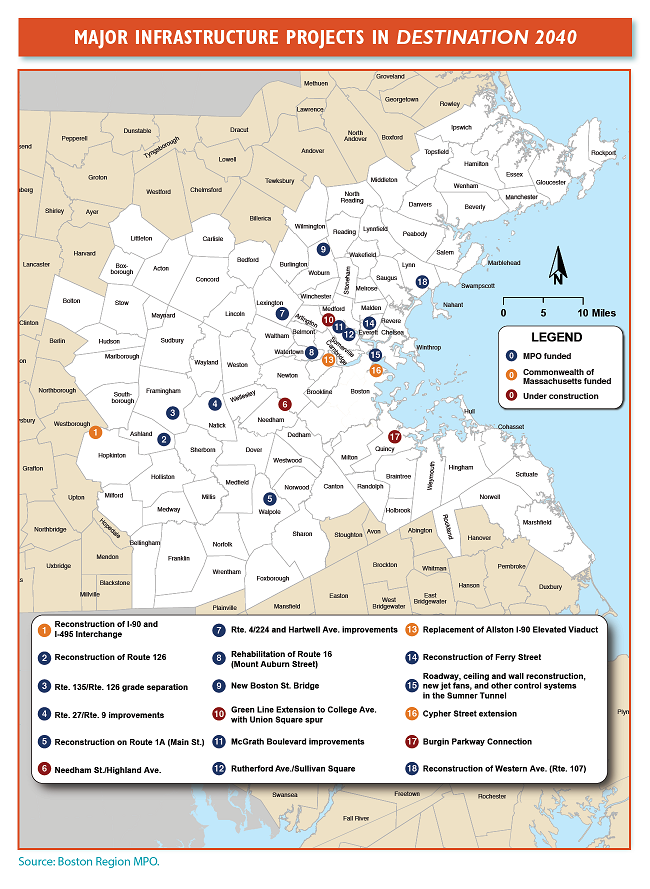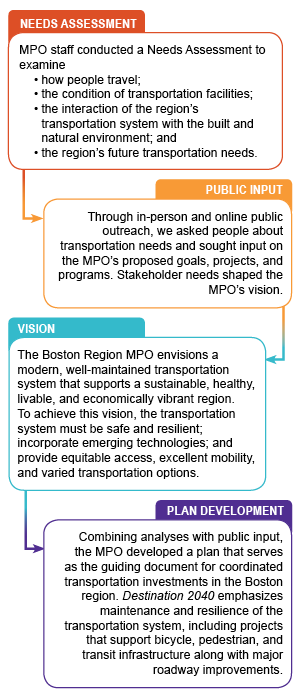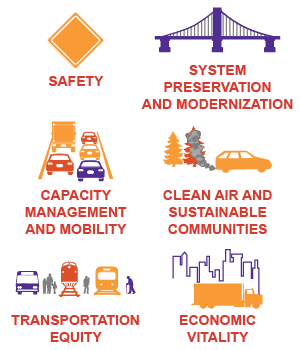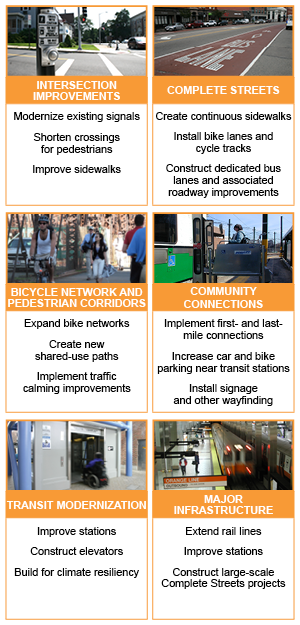An aging population, changing job market, and continued demand for more housing are all forces that will shape the Boston region over the next 20 years. Increased congestion, stressed transportation infrastructure, and climate change present challenges to the long-term vitality of the region. The Boston Region Metropolitan Planning Organization’s (MPO) new Long-Range Transportation Plan (LRTP), Destination 2040, was developed to help the region address these challenges within this changing context.
Destination 2040 establishes a vision for the region’s transportation system and identifies both capital investments and research studies to support that vision. Destination 2040 consists of two volumes: the Needs Assessment, which analyzes the transportation needs of the region, and the plan, which recommends projects and programs to meet those needs.
Destination 2040 continues the MPO’s practice of setting aside at least half of its discretionary funding for smaller-scale, lower-cost projects that improve mobility and safety for all roadway users, including bicyclists, pedestrians, motorists, and transit riders. Destination 2040 includes new funding opportunities for transit modernization, dedicated bus lane infrastructure, and climate resiliency.
The MPO board considered staff recommendations, federal and state requirements, equity and air quality analyses, financial constraints, and public input before voting to adopt Destination 2040 on August 29, 2019.
Major Infrastructure (MI) Program Updates
The LRTP designates investment programs to guide the MPO’s decision making for its rolling five-year capital plan—the Transportation Improvement Program (TIP). Investment programs provide direction for the kinds of lower-cost projects the MPO will consider funding via the TIP throughout the life of the plan, and signal to municipalities and agencies that the MPO has funds available for specific types of projects.
Destination 2040 includes a MI investment program and lists specific major transportation infrastructure projects the MPO plans to fund over the next 20 years. For Destination 2040, MI projects were defined as those that cost more than $20 million and/or add capacity to the transportation network.
On April 30, 2020, the MPO board approved an amendment to Destination 2040. Amendment One updated the LRTP to include projects that had met the MPO’s $20 million dollar threshold for inclusion since the adoption of Destination 2040, to reflect cost changes for four projects already listed in the LRTP, and to provide consistency between the LRTP, the Federal Fiscal Years (FFYs) 2020–24 TIP and its amendments, the proposed FFYs 2021–25 TIP, and the Massachusetts Capital Investment Program. For more information, refer to Amendment One to Destination 2040 (HTML).
Between August and October 2020, the board approved a set of new policies to better define the types of large-scale projects that qualify for the MI program. Going forward, projects funded under the MI program in the TIP include those that meet at least one of the following criteria:
- Projects that improve facilities that are important to regional travel, which include Interstate Highways; Principal Arterial Freeways and Expressways; or all sections of roadways classified as Principal Arterial “Other” that have fully or partially controlled access
- Projects that add new connections to or extend the rail or fixed guideway transit network or the bus rapid transit network
- Projects that cost $50 million or more
This set of policies also states that the only MI projects that will be listed in the LRTP are those required to be listed under federal regulation and fall within the first 10 years of the plan. The new policy also describes a new scoring and review process for MI projects that are or may be included in the LRTP. For more information, refer to Adopted Policies for the MPO’s Major Infrastructure Program (PDF) Adopted Policies for the MPO’s Major Infrastructure Program (HTML).


Destination 2040: PDF and Accessible Formats
- Destination 2040 Full Document (PDF) (HTML)
- Table of Contents (PDF) Table of Contents (HTML)
- Executive Summary (PDF) Executive Summary (HTML)
- Resumen Ejecutivo (PDF) Resumen Ejecutivo (HTML)
- Sumario Executivo (PDF) Sumario Executivo (HTML)
- Rezime Egzekitif (PDF) Rezime Egzekitif (HTML)
- 执行总结 (PDF) 执行总结 (HTML)
- 執行總結 (PDF) (HTML)
- Chapter 1: Introduction and Process (PDF) Chapter 1: Introduction and Process (HTML)
- Chapter 2: Transportation Needs in the Boston Region (PDF) Chapter 2: Transportation Needs in the Boston Region (HTML)
- Chapter 3: Funding the Transportation Network (PDF) Chapter 3: Funding the Transportation Network (HTML)
- Chapter 4: The Recommended Plan (PDF) Chapter 4: The Recommended Plan (HTML)
- Chapter 5: System Performance Report (PDF) Chapter 5: System Performance Report (HTML)
- Chapter 6: Transportation Equity Performance Report (PDF) Chapter 6: Transportation Equity Performance Report (HTML)
- Chapter 7: Air Quality Conformity Determination and Greenhouse Gas Analysis (PDF) Chapter 7: Air Quality Conformity Determination and Greenhouse Gas Analysis (HTML)
- Chapter 8: Next Steps: Implementation of Destination 2040 (PDF) Chapter 8: Next Steps: Implementation of Destination 2040 (HTML)
- Appendix A: Universe of Investment Programs and Projects (PDF) Appendix A: Universe of Investment Programs and Projects (HTML)
- Appendix B: Destination 2040 Project Evaluation Methodology (PDF) Appendix B: Destination 2040 Project Evaluation Methodology (HTML)
- Appendix C: Draft Disparate Impact and Disproportionate Burden Policy for the Long-Range Transportation Plan (PDF) Appendix C: Draft Disparate Impact and Disproportionate Burden Policy for the Long-Range Transportation Plan (HTML)
- Appendix D: Public Outreach for Destination 2040 (PDF) Appendix D: Public Outreach for Destination 2040 (HTML)
- Amendment One to Destination 2040 (HTML)
HOW DID THE MPO DEVELOP
DESTINATION 2040?

WHAT ARE THE GOALS FOR
DESTINATION 2040?

WHAT TYPES OF PROJECTS AND INVESTMENT PROGRAMS DOES DESTINATION 2040 FUND?

Additional Resources
- Destination 2040 Program Guide
- Proposed Changes to Existing Vision, Goals, and Objectives (HTML)
- Vision, Goals, and Objectives: Public Comments and Survey Results (PDF) Vision, Goals, and Objectives: Public Comments and Survey Results (HTML)
- Destination 2040 Vision, Goals, and Objectives
- Destination 2040 Financial Handout
- Key Descriptions of Projects in the Long-Range Transportation Plan Universe of Projects
- Universe of Projects with Additional Conceptual Projects
- Universe of Projects
- Key Descriptions of Projects in the LRTP Universe (Additional District 4 Projects)
- Key Descriptions of Projects in the LRTP Universe (Districts 3, 5, and 6)
- Map of MassDOT Highway Districts
- Universe of Programs
- Transit Modernization Program Description
- Dedicated Bus Lane Program Description
- Table of High-Priority Bus Route Segments
- Universe of Programs Survey Responses
- Staff Recommendations for Funding Goals
- Major Infrastructure Projects Summaries and Evaluation Scores
- Summary of Evaluated Major Infrastructure Projects
- Universe of Projects Survey Responses
- Major Infrastructure Projects Summaries and Evaluation Scores, Revised 5/10/19
- Staff Recommended Funding Scenarios
- Major Infrastructure Project Summaries and Evaluation Scores, Revised May 17, 2019
- Staff Recommended Funding Scenarios

Contact Information

